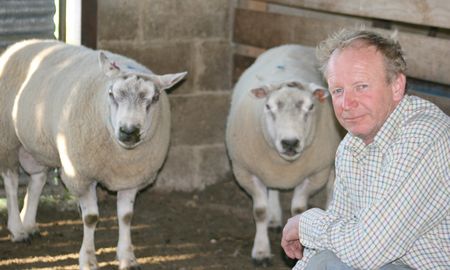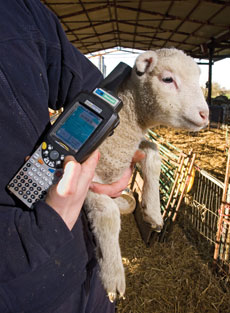Time is gone for EID stalling

Electronic identification (EID) is seen by many sheep farmers as an unwelcome, costly burden on the industry. But one of the UK’s largest sheep farmers, Frank Langrish, based in Udimore, Sussex, believes the industry must embrace the technology.
“In recent weeks I have been criticised for putting forward views on EID which are contrary to many organisations’ beliefs. So, I felt it necessary to write the following piece about where I believe the sheep industry should be going and on the misinformation and disinformation that the technology does not work. I can assure you it does work.
To be perfectly clear I will give you my position on EID and try to explain my concerns over the NFU and other organisations’ ongoing outright objections to it.
Whether we like it or not, the regulation is, at present, written in EU regulation and the opportunity to object on the original proposals are lost. Although, I accept it is never too late to bring change.
Many EU member states are already a long way down the road of implementing EID. Admittedly these are smaller sheep-keeping countries, but they are seeing it as a way to protect their industry. Others have already thrown money at kick starting it.
I am nervous a lack of EID in the UK could be used against our essential export business, both live and dead.
New Zealand is also moving to EID for management purposes related to improved breeding and I am convinced the progressive farmers here will also use the technology to advance our fragile industry.
I believe a voluntary approach would be preferable. However, there is an important caveat to that as it is important to ensure we have a single system and preferably a single database.
EID will not work without the database and that is where we have an opportunity to change and improve many of the unworkable regulations we live with at the moment.
The ideology of all ID as far as the EU and our own authorities are concerned relates to disease control. The present system of movement recording for sheep is a total farce and has moved backwards over the last two years.
 |
|---|
| The new regulations with double-tagging and the necessity to cross reference tags is potentially far more arduous than an EID system, says Frank Langrish. |
While not wanting to go off on a tangent I am sure that if EID had come in first for cattle the debate about sheep EID would be irrelevant. This is for two reasons: firstly, the cost of tags is high and adding a chip would make little difference to the price and the opportunity to have a paperless (no passport) system that could easily be operated in “real time”.
By that I mean all movements would be transferred electronically through the central database, removing most human errors and reducing the costs in administration at Workington that farmers will eventually have to pay for.
Returning to sheep, the new regulations with double-tagging and the necessity to cross reference tags, etc. is potentially far more arduous (and probably costly when done correctly) than an EID system, particularly those farmers buying in stock and also sending to different grazing areas more than five miles from their main holding.
There is some confusion – for myself included – on the situation where we are away wintering bought-in sheep on a single tag. At present the only recorded movement (batch) is of those sheep moving from one holding to another in relation to an ear tag of the holding of birth. After that if I have brought that batch back to my own holding then send it out, the record of that sheep’s movements is effectively lost.
We may all agree it is not necessary to have that information, but I believe the EU wants and thinks that we need to have it for disease control and may impose a paper-based system where we could be forced to read ear tags. In fact we should probably already be doing this in our flock registers.
There are two distinct differences in our sheep industry as regards ID. Ever since compulsory tagging was introduced we have all accepted it as another necessary cost and have received no tangible benefit. A small number of progressive (mostly pedigree) producers have used ID to advance the breeding of their animals and now more lowland producers are looking at EID to improve commercial flocks where they are breeding their own replacements.
The cost benefits of EID and the voluntary approach will I believe happen anyway in this sector. However, these sheep seldom move far from the holding of birth.
The biggest problem area and hence the most vociferous lobby are hill farmers who gather their stock infrequently and have recently had low levels of income. However, from a traceability point of view it is often these animals that travel the greatest distances and pass through the most hands.
They are also the producers who appear to be less concerned about productivity and sheep improvement because they are so far away from the consumer of the meat the progeny of their animal will produce.
These people mostly sell their stock on the fact that they have made them look a pretty colour or they have ears that are the right length. I am being facetious of course, but they get no feedback and may not want any as to the efficiency of their flock or breeding program.
A lot of the debate is around cost. The small producer (80% who have 20% of the sheep) will not need to buy the reading equipment if they do not wish to as they will be able to manually record the ID’s if they need to.
We do need to ensure that we can use single tags with a chip included in them as it appears now we have to have a WSYSIWYG system, using single tags will reduce costs and will not be much higher than the present double-tagging.
While the stock will need to be identified on leaving the holding, the information can be submitted manually or electronically. The animals will possibly need to be verified on arriving at the next holding, or if it is a market they will need to be identified for onward movement.
There will always be tag losses and non-reads and the system will have to be capable of accepting a “batch” movement, however, it will be possible to identify the missing numbers and if required these could be re-tagged and the number related back to the farm of origin as is required with the present legislation in the flock book.
In a situation where a store lamb buyer has many lambs bought from different markets or holdings he will have both batch and individual ID. If he needs to move these to another holding he will be able to scan the chips and any non-reads will be able to re-tag and re-identify to either a batch or individual.
 |
|---|
| Frank Langrish believes a voluntary approach to EID is preferable. |
The abattoirs will need more traceability in the food chain and this may not always work in farmers’ favour. However, EID will work for them, and as technology improves they will link the animal to the carcass and the grading and weight.
At present, the few who give feedback other than by batch have to do it manually. Remember New Zealand and others are looking at using automated grading and back fat scanning to take out human error.
I have already seen a system in place where cattle are killed and pass by a scanner at the start of the dressing process and this information passes through to all the primal cuts. This enables the abattoir to pass back (if required) information to the breeder on conformation and meat-to-bone ratio.
While I am only a dog-and-stick farmer, I always believe we should embrace change and technology if it will lead to an improvement in our business.
I also do not believe in unnecessary regulation that adds cost. However, there is an opportunity here to improve regulation by removing six-day standstill, paper-based movement forms (very few of which are returned in three days). There is also an opportunity to improve and modernise the whole sheep industry that, even with the recent price improvements, is in danger of further decline.
I am a great NFU supporter but I am fearful it is giving the wrong message and which is not based on facts. The few younger farmers I have spoken to locally wish to use EID and are only waiting to see what system will be used.
I must stress that it will be useless unless there is a central database and we, the industry, need to have eventual control of it.
I know that some of our larger abattoirs and supermarkets are looking at supplying EID to their dedicated producers to improve the whole supply chain and there is a real danger they will set up their own databases and enforce direct purchasing by the back door.
We all know that we need to maintain our live market system, but we also need to bring our industry into the 21st century.”
